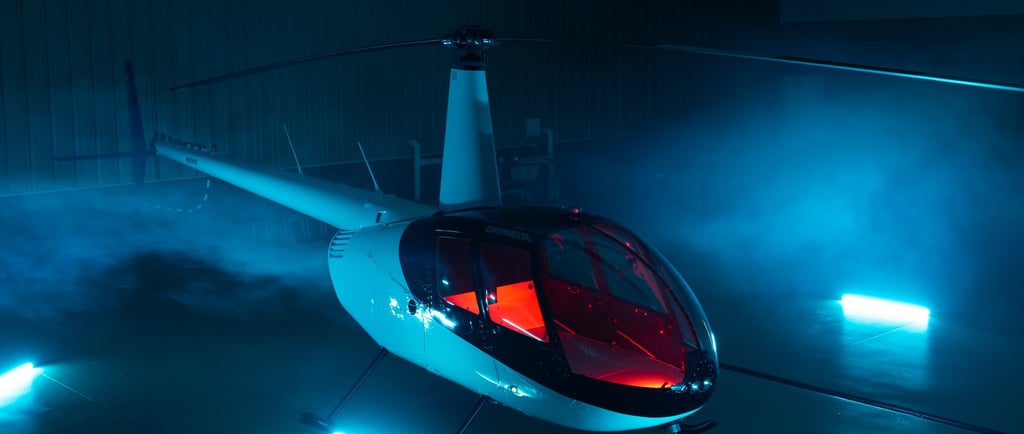Review - Rotor Technologies uncrewed monocopter
Rotor Technologies, led by MIT engineers, converted a Robinson R22 light helicopter (nicknamed “Birdy McBirdface”, model R22S6-01) into a remotely-piloted firefighting drone. Equipped with CloudPilot OS—an advanced system combining flight-control algorithms, computer vision, and satellite comms—it teleoperates via StarLink-like links & VR-enhanced pilot stations
Jon Wettack, Ron Wiener
8/8/20252 min read


🚁 What’s the Drone?
Rotor Technologies, led by MIT engineers, converted a Robinson R22 light helicopter (nicknamed “Birdy McBirdface”, model R22S6-01) into a remotely-piloted firefighting drone. Equipped with CloudPilot OS—an advanced system combining flight-control algorithms, computer vision, and satellite comms—it teleoperates via StarLink-like links & VR-enhanced pilot stations (dronelife.com).
🛫 Maiden Flight at FAA Test Site
Certification: Received experimental FAA clearance on November 30, 2022.
First Flight: On December 2 at FAA’s New York UAS Test Site, it hovered under pilot line-of-sight for 3+ minutes, validating throttle, flight controls, data links, and system redundancy (e.g., tether backup) (dronelife.com).
Payload Performance: With no onboard pilot, it can carry ~400 lb—over double the crewed R22’s ~170 lb—cruising for over three hours .
🌲 Firefighting & Operational Edge
Water/Retardant Delivery
The higher payload allows multiple moderate drops per sortie, serving as a tactical asset for hotspot suppression when larger crews or tankers aren't available.
Extended Mission Duration
With three-hour endurance, it can patrol, observe, or conduct drops efficiently, and return for more—ideal for multi-hour deployments.
Remote & Adverse Operations
Satellite-linked teleoperations and VR interfaces enable operations at night or through smoke when manned aircraft might be grounded (dronelife.com, mdpi.com, cbsaustin.com).
Pilot Safety & Cost Efficiency
Removing pilots from direct exposure lowers risk and can cut costs tied to crew training, support, and regulatory compliance.
⚖️ Advantages vs. Challenges
Strengths
Limitations & Considerations
Higher payload than manned versions
Still relatively small compared to helicopters like Black Hawks or Air-Cranes
Long endurance with no pilot onboard
Requires robust ground-control infrastructure and comms redundancy
Enables night/low-visibility ops via satellite links
Regulatory approval beyond research phase still pending
VR-enhanced teleoperation potentially safer than cockpit visuals
Transitioning from experiment to field-ready demands rigorous testing
🌍 Strategic Outlook & Integration
Development Trajectory: Flying under experimental conditions paves the way for real-world trials in 2023 and beyond, likely with state/federal fire agencies (aerospaceamerica.aiaa.org, urbanairmobilitynews.com, dronelife.com, smithsonianmag.com).
Emerging Drone Aviation Trend: It aligns with recent tests of optionally-piloted helicopters like UAV K-MAX flights at FAA sites (aerospaceamerica.aiaa.org).
Supportive Regulation: FAA-approved flights at test sites hint at a regulatory shift toward optionally piloted aircraft in fire missions.
Scalable Model: If proven effective, CloudPilot could be integrated on larger platforms (e.g., Sikorsky S-70/Black Hawk conversions or Air-Cranes), amplifying payload and range (aerospaceamerica.aiaa.org).
🧭 Final Thoughts
Rotor’s Birdy McBirdface represents a bold leap toward uncrewed aerial firefighting. By harnessing satellite teleoperation, VR-based controls, and a light helicopter platform, it addresses key needs: pilot safety, night ops, and flexible payload delivery.
However, true impact hinges on four factors:
Scaling to larger aircraft,
Securing advanced regulatory clearance,
Validating reliability in wildfire conditions,
Building operational modules like ground command stations.
If these align, this type of uncrewed platform may redefine aerial firefighting—offering swift, scalable, and safer missions at times when manned aviation is hampered.
Want to explore CloudPilot’s tech architecture, compare this with optionally-piloted helicopters like Sikorsky’s Matrix-equipped S-70, or dig into FAA policies around experimental UAVs?